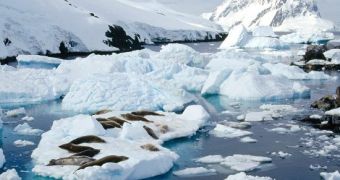A paper published in this week's issue of the Journal of Geophysical Research says that, throughout the past 60 years, the Antarctic Peninsula has experienced its summer melt season starting to last increasingly longer.
Researchers say that, according to their investigations, average summer temperatures in this northernmost part of Antarctica have increased by as much as 3 degrees Celsius since the 1950s.
Interestingly enough, it appears that the Peninsula is currently warming at significantly faster rates than Antarctica's mainland, EurekAlert! says.
Specialists believe that this is a direct result of the Antarctic Peninsula's being hit by stronger local winds coming from the west.
Thus, it appears that these winds collect warm air from the sea and transport it all the way to the Peninsula, causing the snow in this part of the world to melt.
“We found a significant increase in the length of the melting season at most of the stations with the longest temperature records,” argues Dr. Nick Barrand, one of the researchers who took the time to investigate this phenomenon.
“At one station the average length of the melt season almost doubled between 1948 and 2011,” the researcher went on to add.
Dr. Nick Barrand and his colleagues are very much concerned that this lengthening of the Antarctic Peninsula's summer melt season can cause local ice shelves to start breaking up more easily and faster, something that would in turn contribute to a rise in global sea levels.
More precisely, meltwater is now listed as one of the reasons that ice shelves in these regions develop cracks, weaken and eventually collapse.
Furthermore, the constant melting and refreezing of the Antarctic Peninsula's snow coverage is likely to reshape local landscapes, meaning that snow layers in the affected areas are bound to become both thinner and denser.
The funding needed in order to carry out this research was provided by the European Union's ice2sea program.

 14 DAY TRIAL //
14 DAY TRIAL //